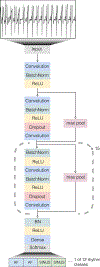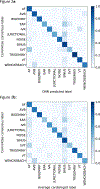Cardiologist-level arrhythmia detection and classification in ambulatory electrocardiograms using a deep neural network
- PMID: 30617320
- PMCID: PMC6784839
- DOI: 10.1038/s41591-018-0268-3
Cardiologist-level arrhythmia detection and classification in ambulatory electrocardiograms using a deep neural network
Erratum in
-
Publisher Correction: Cardiologist-level arrhythmia detection and classification in ambulatory electrocardiograms using a deep neural network.Nat Med. 2019 Mar;25(3):530. doi: 10.1038/s41591-019-0359-9. Nat Med. 2019. PMID: 30679787 Free PMC article.
Abstract
Computerized electrocardiogram (ECG) interpretation plays a critical role in the clinical ECG workflow1. Widely available digital ECG data and the algorithmic paradigm of deep learning2 present an opportunity to substantially improve the accuracy and scalability of automated ECG analysis. However, a comprehensive evaluation of an end-to-end deep learning approach for ECG analysis across a wide variety of diagnostic classes has not been previously reported. Here, we develop a deep neural network (DNN) to classify 12 rhythm classes using 91,232 single-lead ECGs from 53,549 patients who used a single-lead ambulatory ECG monitoring device. When validated against an independent test dataset annotated by a consensus committee of board-certified practicing cardiologists, the DNN achieved an average area under the receiver operating characteristic curve (ROC) of 0.97. The average F1 score, which is the harmonic mean of the positive predictive value and sensitivity, for the DNN (0.837) exceeded that of average cardiologists (0.780). With specificity fixed at the average specificity achieved by cardiologists, the sensitivity of the DNN exceeded the average cardiologist sensitivity for all rhythm classes. These findings demonstrate that an end-to-end deep learning approach can classify a broad range of distinct arrhythmias from single-lead ECGs with high diagnostic performance similar to that of cardiologists. If confirmed in clinical settings, this approach could reduce the rate of misdiagnosed computerized ECG interpretations and improve the efficiency of expert human ECG interpretation by accurately triaging or prioritizing the most urgent conditions.
Conflict of interest statement
Competing interests
Dr. Haghpanahi and Mr. Bourn are employees of iRhythm Inc. Dr. Tison is an advisor to Cardiogram, Inc. Dr. Turakhia is a consultant to iRhythm Inc. None of the other authors have potential conflicts of interest.
Figures




Comment in
-
Artificial intelligence for the electrocardiogram.Nat Med. 2019 Jan;25(1):22-23. doi: 10.1038/s41591-018-0306-1. Nat Med. 2019. PMID: 30617324 No abstract available.
-
Artificial intelligence to improve the diagnosis of cardiovascular diseases.Nat Rev Cardiol. 2019 Mar;16(3):133. doi: 10.1038/s41569-019-0158-5. Nat Rev Cardiol. 2019. PMID: 30683888 No abstract available.
References
-
- Schläpfer J & Wellens HJ Computer-Interpreted Electrocardiograms. J. Am. Coll. Cardiol 70, 1183–1192 (2017). - PubMed
-
- LeCun Y, Bengio Y & Hinton G. Deep learning. Nature 521, 436–444 (2015). - PubMed
-
- Holst H, Ohlsson M, Peterson C & Edenbrandt L. A confident decision support system for interpreting electrocardiograms. Clin. Physiol 19, 410–418 (1999). - PubMed
-
- Schlant RC et al. Guidelines for electrocardiography. A report of the American College of Cardiology/American Heart Association Task Force on Assessment of Diagnostic and Therapeutic Cardiovascular Procedures (Committee on Electrocardiography). J. Am. Coll. Cardiol 19, 473–81 (1992). - PubMed
-
- Shah AP & Rubin SA Errors in the computerized electrocardiogram interpretation of cardiac rhythm. J. Electrocardiol 40, 385–390 (2007). - PubMed
Methods-only References
-
- He K, Zhang X, Ren S & Sun J. Identity mappings in deep residual networks. in European Conference on Computer Vision 630–645 (2016).
-
- Ioffe S & Szegedy C. Batch Normalization: Accelerating Deep Network Training by Reducing Internal Covariate Shift. Int. Conf. Mach. Learn 37, (2015).
-
- He K, Zhang X, Ren S & Sun J. Deep Residual Learning for Image Recognition. in IEEE Conference on Computer Vision and Pattern Recognition 770–8 (2016). doi:10.1109/CVPR.2016.90 - DOI
-
- Srivastava N, Hinton G, Krizhevsky A, Sutskever I & Salakhutdinov R. Dropout : A Simple Way to Prevent Neural Networks from Overfitting. J. Mach. Learn. Res 15, 1929–1958 (2014).
-
- Kingma DP & Ba JL Adam: A method for stochastic optimization. in International Conference on Learning Representations 1–15 (2015).
Publication types
MeSH terms
Grants and funding
LinkOut - more resources
Full Text Sources
Other Literature Sources
Medical

